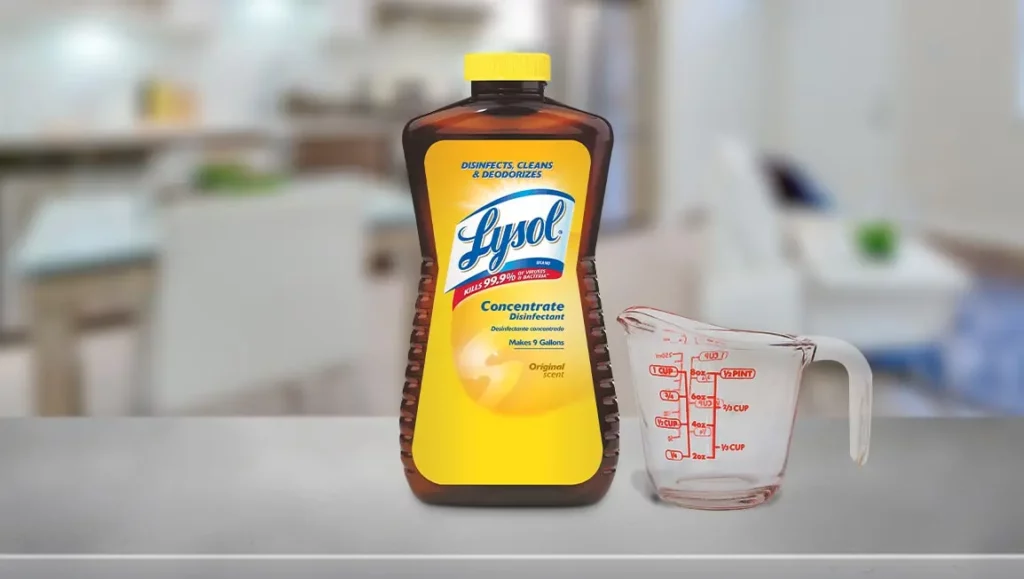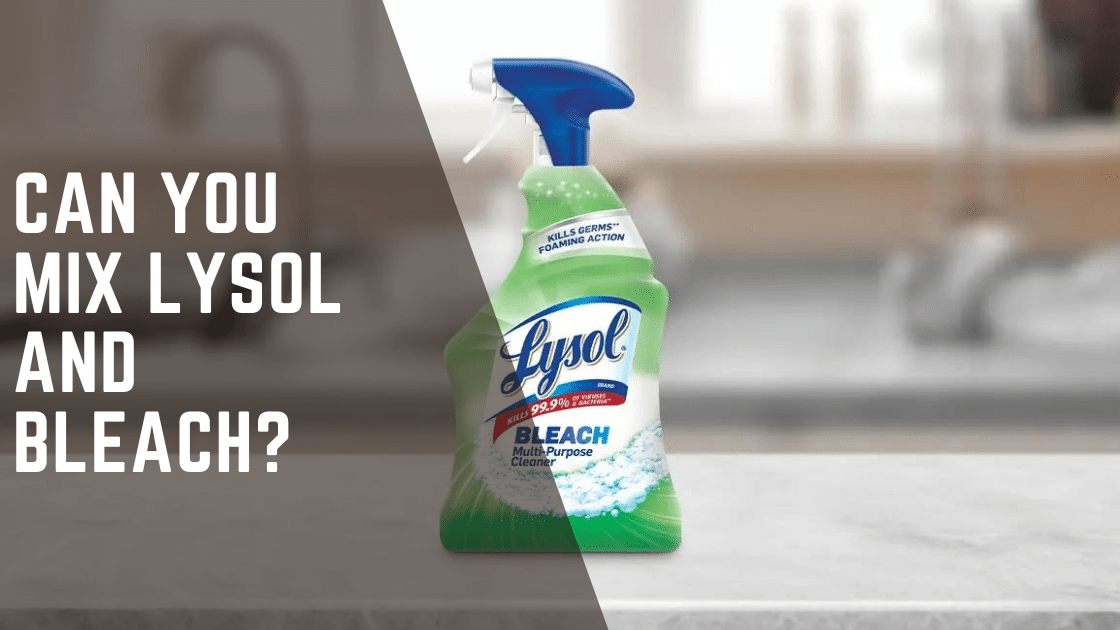Published by Enaam Siam on April 16, 2023 | Last updated on May 14, 2023
Cleaning is essential for maintaining a healthy and safe environment. However, some cleaning products can be hazardous when mixed with other chemicals. Bleach and Lysol are two common cleaning agents that are known to be effective in their respective uses. The question is Can You Mix Lysol and Bleach?
When it comes to cleaning, many people are often unaware of the potential danger of mixing different cleaning agents. One such combination that people commonly ask about “Can You Mix Lysol and Bleach?” While both are effective cleaners, it is important to understand the potential risks of mixing these two chemicals.
This CleanersAdvisor guide will explore the truth behind this question and improve vital information to keep you and your loved ones safe.
Visit our other CleanersAdvisor guides, to read more about Can You Mix Borax and Bleach?, Can You Mix Bleach and Baking Soda? and Can You Mix Pine Sol and Bleach without Harmful and Poisonous Effect
- What is Lysol?
- What is Bleach?
- Can You Mix Lysol and Bleach?
- What Happens When You Mix Lysol and Bleach?
- What are the Symptoms of Exposure to Chlorine Gas?
- What Should You Do If You Accidentally Mix Lysol and Bleach?
- What Should You Do Instead?
- How Can You Safely Clean Using Lysol and Bleach?
- What are Some Alternatives to Mixing Lysol and Bleach?
- Can You Mix Lysol and Bleach FAQs
- Conclusion
What is Lysol?
Lysol is a brand of disinfectant that is commonly used to kill germs and bacteria on surfaces. It contains a variety of active ingredients, such as ethanol, isopropyl alcohol, and hydrogen peroxide, that work together to kill harmful microorganisms.

What is Bleach?
Bleach is a powerful oxidizing agent that is commonly used for whitening clothes, removing stains, and disinfecting surfaces. It is made up of sodium hypochlorite, which is highly reactive chemical that can release toxic fumes when mixed with other cleaning agents.

Can You Mix Lysol and Bleach?
The answer is NO! Mixing Lysol and bleach is a dangerous combination because it creates a toxic gas called chloramine. This gas can cause a range of health problems, including:
- Respiratory issues: Chloramine can irritate the nose, throat, and lungs, causing coughing, wheezing, and difficulty breathing. In severe cases, it can lead to bronchitis or pneumonia.
- Eye and skin irritation: Chloramine can also irritate the eyes and skin, causing redness, itching, and burning.
- Nausea and vomiting: Inhaling chloramine can cause nausea, vomiting, and stomach pain.
- Headaches and dizziness: Exposure to chloramine can also lead to headaches and dizziness.
These symptoms can be especially dangerous for people with pre-existing respiratory conditions, such as asthma or COPD. In severe cases, exposure to chloramine can even be fatal.
What Happens When You Mix Lysol and Bleach?
When you mix Lysol and bleach, the bleach reacts with the hydrogen peroxide in the Lysol to create chlorine gas. This gas then reacts with the ammonia in the Lysol to produce chloramine. The chemical reaction happens quickly, and the gas can fill a room in just a few minutes.
The danger of this gas is that it’s heavier than air, which means it can sink to the floor and accumulate in low-lying areas, such as basements or bathrooms. This can make it even more dangerous because people may not realize they’re being exposed to it until it’s too late.
What are the Symptoms of Exposure to Chlorine Gas?
Exposure to chlorine gas can cause a variety of symptoms, including:
- Coughing and wheezing
- Chest pain and tightness
- Burning eyes and nose
- Difficulty breathing
- Nausea and vomiting
- Headache and dizziness
What Should You Do If You Accidentally Mix Lysol and Bleach?
If you accidentally mix Lysol and bleach, the first thing you should do is evacuate the area immediately. Chlorine gas can quickly spread and cause harm to anyone in the vicinity. You should also seek medical attention immediately if you experience any symptoms of exposure to chlorine gas.
What Should You Do Instead?
If you want to disinfect your home, there are safer alternatives to mixing Lysol and bleach. Here are some options:
- Use a disinfectant that’s specifically designed for the surface you’re cleaning. For example, if you’re cleaning a countertop, use a disinfectant that’s safe for food surfaces.
- Use bleach or Lysol separately. If you want to use bleach, dilute it with water according to the instructions on the label. If you want to use Lysol, follow the instructions on the label for how to use it safely.
- Open windows and doors to improve ventilation. If you’re using any type of cleaning product, it’s important to have good air circulation in your home. This can help reduce your exposure to any fumes or gases that may be produced.
- Wear protective gear. If you’re using bleach or another strong cleaning product, consider wearing gloves, goggles, and a mask to protect yourself from exposure.
How Can You Safely Clean Using Lysol and Bleach?
To safely clean using Lysol and bleach, it is important to use them separately and follow the manufacturer instruction. When using bleach, it is important to dilute it with water to reduce its concentration. When using Lysol, it is important to use it in a well-ventilated area to avoid inhaling the fumes.
What are Some Alternatives to Mixing Lysol and Bleach?
If you are looking for an alternative to mixing Lysol and bleach, there are several options available. Some effective alternatives include:
- Using hydrogen peroxide to disinfect surfaces.
- Using vinegar and baking soda to clean and deodorize surfaces.
- Using a combination of dish soap and water to clean surfaces.
Can You Mix Lysol and Bleach FAQs
Conclusion
In conclusion, it is not safe to mix Lysol and bleach. When these two chemicals are combined, they can release chlorine gas, which can extremely be hazardous to your health.
It is important to use these cleaning agents separately and to follow the manufacturer’s instructions carefully to avoid any potential dangers. By taking the necessary precautions, you can ensure that your home stays clean and safe for you and loved ones.


![Criterion Dishwasher Reviews [According to 2023 Tests]](https://cleanersadvisor.com/wp-content/uploads/2023/03/Blog-Banner-for-Website-Content-41-350x190.png)
![Zline Dishwasher Reviews [According to 2023 Tests]](https://cleanersadvisor.com/wp-content/uploads/2023/03/Blog-Banner-for-Website-Content-42-350x190.png)

![GE Dishwasher Reviews [According to 2023 Tests]](https://cleanersadvisor.com/wp-content/uploads/2023/03/Blog-Banner-for-Website-Content-37-350x190.png)
![Miele Dishwasher Reviews [According to 2023 Tests]](https://cleanersadvisor.com/wp-content/uploads/2023/03/Blog-Banner-for-Website-Content-34-350x190.png)
![Cove Dishwasher Review [According to 2023 Tests]](https://cleanersadvisor.com/wp-content/uploads/2023/03/Blog-Banner-for-Website-Content-31-350x190.png)